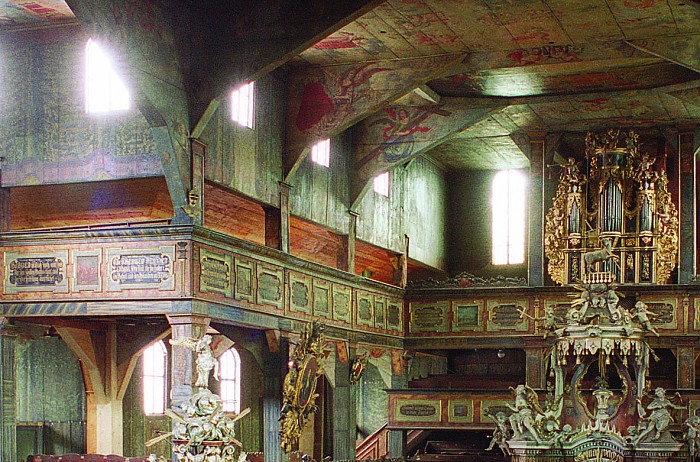

26. November 2008 – 11. January 2009
Cabinet Exhibition
A German-Polish cultural heritage
An Exhibition of the German Cultural Forum for Central and Eastern Europe
The exhibition shows the Silesian Peace Churches in Schweidnitz/?widnica ("On the Holy Trinity") and Jauer ("On the Holy Spirit") in the context of Silesian history and Protestant church building in the Baroque period. Both churches are the largest sacral half-timbered buildings in Europe. They were built in the middle of the 17th century as a result of the Peace of Westphalia, to which they owe their name. In the course of the Counter-Reformation, the Protestant churches were confiscated in the predominantly Protestant Silesia, which belonged to the Catholic House of Habsburg. In the peace treaty of 1648, however, the Silesian Protestants were granted the right to build three new churches. Nonetheless, these had to be located outside the cities and built of wood.
The Peace Churches have survived centuries and now belong to the common cultural heritage of the Germans and Poles. In December 2001, they were included in the UNESCO World Heritage List; Polish and German monument preservationists had worked together to achieve this. The restoration measures in the 1990s were carried out in German-Polish cooperation.
The exhibition aims to present the two Peace Churches in Schweidnitz and Jauer in the context of Silesian history and Protestant church building in Silesia in the Baroque period. The aim is to make these unique buildings known to a broader public.
The Museum for Sepulchral Culture in Kassel is not only concerned with death, burial and mourning culture in the narrower sense, but also with remembrance culture in general. At least since the research of Jan and Aleida Assmann in the 1990s, cultural memory has become a standing concept. In this, the spiritual and material traditions that shape our consciousness of time and history, our self-image and world view are bundled. Cultural memory includes material manifestations, such as cemeteries and burial grounds, but it is by no means only that. The culture of memory cannot be reduced to graves. That is why the Museum of Sepulchral Culture additionally deals with other forms of identity-forming experience and commemoration, church spaces included.
We would like to thank the German CULTURAL FORUM for Central and Eastern Europe, Potsdam, for making the exhibition available and the Hessian Ministry of Social Affairs and the Austrian Ministry of Science and Research for the financial support of the project.
Arbeitsgemeinschaft Friedhof und Denkmal e.V.
Zentralinstitut für Sepulkralkultur
Museum für Sepulkralkultur
Weinbergstraße 25–27
D-34117 Kassel | Germany
Tel. +49 (0)561 918 93-0
info@sepulkralmuseum.de








